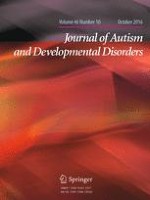30-07-2016 | Brief Report
Brief Report: Early VEPs to Pattern-Reversal in Adolescents and Adults with Autism
Gepubliceerd in: Journal of Autism and Developmental Disorders | Uitgave 10/2016
Log in om toegang te krijgenAbstract
Autism spectrum disorder (ASD) is characterized by atypical visual perception both in the social and nonsocial domain. In order to measure a reliable visual response, visual evoked potentials were recorded during a passive pattern-reversal stimulation in adolescents and adults with and without ASD. While the present results show the same age-related changes in both autistic and non-autistic groups, they reveal a smaller P100 amplitude in the ASD group compared to controls. These results confirm that early visual responses are affected in ASD even with a simple, non social and passive stimulation and suggest that they should be considered in order to better understand higher-level processes.
